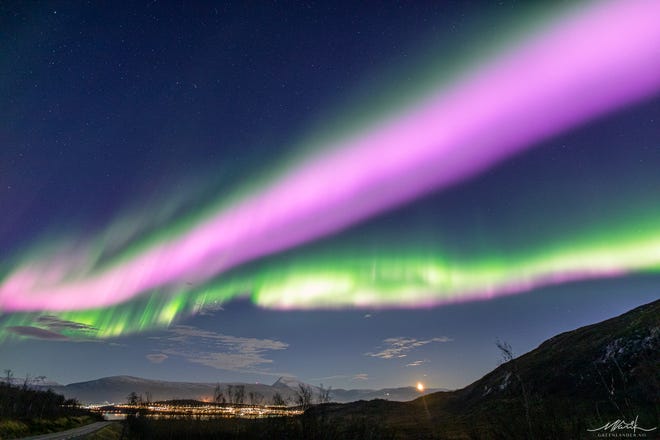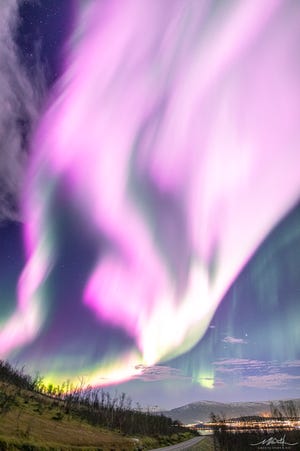Crack in Earth's magnetic field triggers extremely rare pink auroras witnessed in Norway
USA TODAY
Want to know what the night sky looks like after a solar storm smashes into earth and rips a hole into the planet’s magnetic field?
The combination of cosmic events led to a rare explosion of strikingly vivid pink auroras the filled Norway's night sky. The unusual colored light show lasted for around two minutes and was caused by a crack in Earth's magnetic field, enabling highly energetic solar particles, known as solar wind, to enter into the atmosphere on Nov. 3, according to Spaceweather.com.
Greenlander tour company guide Markus Varik spotted the auroras at around 6 p.m. while leading a tour group near Tromsø, Norway, Varik told USA TODAY. Although the pink auroras weren’t the best he’s ever witnessed before, the color's intensity was “super rare” and “almost never happens,” Varik said.

Varik said he has conducted over 1,000 tours of Norway’s auroras as a guide for over 10 years, but these were the strongest hues of pink and purple he’s witnessed in his entire life.
Canadian Pacific Holiday train returns:CP holiday train set to return to eight US states for first time since 2019
Varik said that auroras are usually green, the color of oxygen atoms being struck by energetic particles, but purple shades can occur under “rare” conditions when electrons penetrate deep into the atmosphere and collide with molecules of nitrogen.

“The Northern Lights are always different, never the same. It’s like us, people, completely unique in our own special ways,” Varik said. “When the auoras give us a blessing to be able to experience this kind of phenomena, it always goes very spiritual to me.”
Auroras, usually between 62 and 186 miles above Earth's surface, are formed when streams of solar wind pass around the planet's magnetic field and superheat gases, which then glow in the night sky.
Auroras are more common at the North and South Poles, areas with weaker shields for cosmic radiation, according to NASA.
Camille Fine is a trending visual producer on USA TODAY's NOW team.
No comments:
Post a Comment